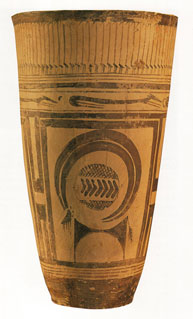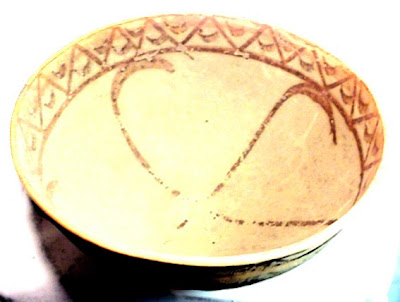A History of Ceramics
After cave paintings, pottery is one of the most ancient manifestations of graphic design. From the ancient times, artists from around the world have used pottery to communicate various aesthetic, cultural, religious, ethical, and socio-political communications. In fact, pot debris discovered at archaeological sites have provided historians and social scientists with a plethora of recorded facts on the people, cultures, economic and trade relationships, systems of beliefs and so on. . The earliest finds of clay pots in Mede, Assyria, Summer, Persia, Egypt and Cartage date from Neolithic times, around the 8th millennium BC.
The frog is commonly worshiped by early Yellow River residents. The motif was passed down to classical Chinese culture as well. Majiayao culture is a group of Neolithic communities who lived primarily in the upper Yellow River region in Gansu and Qinghai, China. The culture existed from 3100 BC to 2700 BC.
 |
| Painted pottery jar from the Machang type of Majiayao culture, 2200-2000 B.C. On display at the Shanghai Museum. |
During the Neolithic revolution, nomadic hunters and gatherers in these lands learned how to cultivate, and were settling down as farmers. They began to produce large clay pots for watering their crops. The prehistoric pots were made by stacking of coils of puttied clay, which were then evened out and fired in a primitive kiln made by digging an underground chamber, beneath a bonfire. Between the 5th and the 3rd. millennium B.C., ancient Egyptians began to decorate their vessels with artistic images, and geometrical designs.
With the invention of the potter’s wheel in Mesopotamia, between the 6th and 4th millennium BC, demand for the utilitarian wares such as storage jars for oil, water, wine, and grain, as well as bowls, cups, and mugs were so high that potters needed to increase production. But the production technology was cumbersome and the fact that the potter wasted too much time, because had to walk around the putty to give shape to the ware, led to the invention of slow “wheel”. This was a large, heavy stone, which was placed on a pivot and then spun by means of ‘kicking’, or pushing with the feet while in a sitting position. As the stone was building up momentum, the artist hands were shaping, or ‘throwing’ the pot on top of it.
 |
| Tepe Sialk, c.4400 - 4200 BC. A nicely painted bowl with crème slip and brown linear designs of a row of ibexes and water symbols. |
Around the 3rd. millennium B.C., the beginning of the Bronze Age, potters developed the high-speed spinning wheel, which increased their productivity. At Gansu, in northwestern China, vessels from the Pan-shan culture, made from finely textured clay and fired to buff or reddish-brown, were brush painted with mineral pigments in designs of strong S-shaped lines converging on circles. They date from 2600 BC. Lung-shan pottery, from the central plains, was wheel made. "Celadon", qingci in Chinese青瓷 which is high-fired green wares and is characterized by its simple but refined design and jade-like glaze. Celadon was produced systematically in Zhejiang during the Eastern Han dynasty but appeared as far back as the Shang dynasty. Its production spread to Jiangsu, Hubei, Hunan, and Jiangxi in the 3rd and 4th centuries; where the wares of superior quality were fired at 1300'.
However, it was the invention of porcelain, from white kaolin clay combined with ground granite, during the Han Dynasty in China around 600 A.D., that gave a strong impetus to the concept of aesthetic design. These fragile and sophisticated pieces of fine china were costly to produce and to export since they required to be fired at tremendously high temperatures, and difficult to transport due to their fragility. To compete with high cost porcelain, Western Asian countries discovered lead glazes that added color and shine to earthenware.
The artists in Persia and Greece adopted this technology and revolutionized the art of graphic design. Persian designs were based on minimalist stylization of various animals, and geometric patterns in black outline. Greeks depicted mythological scenes on their amphora (a tall, two-handled pitcher for storing wine, corn, oil, or honey); hydria (a three-handled water jug); and other vessels. Artists utilized the oxidizing process and reducing kilns to produce a shiny black slip on a cream, brownish, or orange-buff body, depending on the type of clay. The designs were harmonious and very well integrated with the shape of vessels.
 |
| Reveling Satyrs, Attic psykter (wine cooler) in the red-figure style, signed by Douris, c. 480 BC; in the British Museum, London. Courtesy of the trustees of the British Museum |
The red-figure style in pottery was appeared around 530 B.C. This was an inversion of the image in which, the backdrop was painted black, where the outline of the image in negative was delineated by the terracotta color of the earthenware shell. Artists completed the image by elaborating the details of drawing in various shades of black, red, white and sometimes gold paint.
The design on this reddish clay covered in white slip is composed by alternating lines of calligraphy and stylized leaves separated by roundels on stems. The color scheme in manganese, olive and reddish brown on the creamy background complements the elegant composition.
During the Seljuk dynasty of Iran, that ruled over Iraq, Asia Minor, and Syria during the 12th to13th centuries, the Iranian potters in the cities of Rayy and Kāshān developed whiteware pottery. These prosperous cities during this time were located on the trade routes of Asia, and thereby were exposed to various stylish trends and technological improvements in different countries. The potters of these cities adopted the recently developed white body in Egypt, made of Kaolin based mixtures, and combined them with the forming and firing processes to create very fine whiteware, which was decorated with bold carving, occasional piercing, and translucent glaze. Most of these wares have been excavated at Rāy a city near Teheran.
The Metropolitan Museum of Art
The Metropolitan Museum of Art
Fritware is a type of pottery which was first developed in the Near East, where production is dated to the late first millennium AD through the second millennium AD. Frit was a significant ingredient. A recipe for “fritware” dating to 13th century written by Abu’l Qasim reports that the ratio of quartz to “frit-glass” to white clay is 10:1:1. Iznick pottery which was produced in Ottoman Turkey in the 15th century consisted of a body, slip, and glaze, where the body and glaze are 'quartz-frit' containing lead oxide and soda. Chinese blue-and-white porcelain influenced the style of Safavid pottery and had a strong impact on the development of Iznik ware. By the mid-16th century, Iznik had its own vocabulary of floral and abstract motifs in tight designs making use of a limited palette. Decoration progressed from pure symmetry to subtle rhythms.
Iznik dish About 1565 AD
Iznik wares were decorated with elaborate floral patterns known as "Hatay" (Cathay) with Chinese cloud patterns and geometric designs. Early Iznik fritware attempted to duplicate the hardness, whiteness and translucency of much sought after near contemporary Chinese porcelain of the Yung and Ming dynasties (favored by the Ottoman rulers).
Iznik wares were decorated with elaborate floral patterns known as "Hatay" (Cathay) with Chinese cloud patterns and geometric designs. Early Iznik fritware attempted to duplicate the hardness, whiteness and translucency of much sought after near contemporary Chinese porcelain of the Yung and Ming dynasties (favored by the Ottoman rulers).
Mina’i ware, an enamel-overglaze pottery developed by the potters of Kashan was another imprtant invention during the Saljuk dynast . Mina'i means enamel or a low fire glaze, usually fluxed with lead. The main reason popularity of Mina'i was the wide selection of colors that the process offered. The artists at first bisque fired the work, and then painted it with underglaze cobalt, covered with a transparent glaze and fired again to melt the glaze. At the final stage of the process, the oil based enamels were painted onto the design and the piece fired for multiple times at low temperatures which made it possible to have various colors.
The Mongol Empire era that spanned across Asia to Eastern Europe during the 13th and 14th century was a period of increased cultural exchanges among the nations inside this largest contiguous empire in the history of the world. The Iranian artists of the Mongol era in the city of Kāshān, adopted the Chinese celadon green glazes during the13th century. Over the same period, the Chinese artists of the Mongol dynasty of Yuan (1279–1368) introduced the Iranian underglaze blue to China. In fact, historical records indicate that the Chinese source of cobalt was Iran. The Chinese potter further improved the Iranian technique and during the Ming (1368–1644) and Qing (1644–1911) dynasties created the blue-and-white wares. This underglaze blue was introduced to Europe from China by Dutch merchants.
The early 1500's would see the establishment of Safavid rulers at their capital of Tabriz and the beginning of a 200 year period of relative stability. During this era the Kubachi style for wares developed in north-western Iran, (the style took its name from the town of Kubachi, presently in the republic of Daghestan in the Caucasus, where they have been excavated). These large polychrome plates, which were painted underneath their crackle glazes have a very soft body, a brilliant crackled glaze, and rhythmical and spontaneous designs. In the 16th century , the Ming Dynasty of China issued a decree banning all foreign trade and closed down all seaports along the coast. These Hai jin laws that came during the Wokou wars with Japanese pirates slowed the export of porcelain, and Dutch merchants looked to Persia to produce pottery in the Chinese style for export. The Iranian potters took the advantage of this opportunity and developed the Gombroon style, which took its name from the port of Gombroon , an English trading post in Iran ( now Bandar Abbās). These Gambroon wares with delicate carved designs on translucent white earthenware bodies were exported to Europe and the Far East in the 16th and 17th centuries.
A Safavid Gombroon pottery bowl, Persia, 17th century. The artist has painted a sophisticated geometric blue medallion, accentuated by black stars over the white interior of this magnificent bowl.
Co to the next chapter; Chapter 13 - Native American Pottery
Co to the next chapter; Chapter 13 - Native American Pottery
References
- Liefkes, Reino and Hilary Young (ed), Masterpieces of World Ceramics, V&A Publishing, 2008, ISBN: 9781851775279.
- Robert J. Charleston (Editor), World Ceramics: An Illustrated History, Book Sales, 1978, ISBN-10: 0890090629
- Hugo Munsterberg, World Ceramics, Studio; First Edition, 1998, ISBN-10: 0670867411
- H. and M. Munsterberg, World ceramics from Prehistori (New York, Penguin Studio Books, 1998)
- Emmanuel Cooper, Ten Thousand Years of Pottery, University of Pennsylvania Press, 2000, ISBN-10: 0812235541
- P.O. Harper, J. Aruz, and F. Tallon, The royal city of Susa (New York, Metropolitan Museum, 1992)
- Notes on an Early 'Persian' Bowl and 'Rice-Grain' Wares, by R. L. Hobson © 1907 The Burlington Magazine Publications, Ltd.
- Arthur U. Pope , and Phyllis Ackerman, A survey of Persian art from prehistoric times to the present, Charles E Tuttle Co, 1981, ISBN-10: 4893600192 ( Oxford University Press, 1965)
- A guide to the Islamic pottery of the Near East, British Museum. Dept. of Oriental Antiquities and of Ethnography, Robert Lockhart Hobson, Printed by order of the Trustees, 1932, Original from the University of Michiganv
------------------------------------------------------------------------------------

This work is licensed under a Creative Commons Attribution-No Derivative Works 3.0 Unported License.
This work is licensed under a Creative Commons Attribution-No Derivative Works 3.0 Unported License.













No comments:
Post a Comment